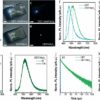Physicists at the University of Regensburg have choreographed the shift of a quantized electronic energy level with atomic oscillations faster than a trillionth of a second.
Throwing a ball into the air, one can transfer arbitrary energy to the ball such that it flies higher or lower. One of the oddities of quantum physics is that particles, e.g., electrons, can often only take on quantized energy values—as if the ball was leaping between specific heights, like steps of a ladder, rather than flying continuously.
Qubits and quantum computers as well as light-emitting quantum dots (Nobel Prize 2023) make use of this principle. However, electronic energy levels can be shifted by collisions with other electrons or atoms. Processes in the quantum world usually take place on atomic scales and are also incredibly fast.
Using a novel type of ultrafast microscope, a team from Regensburg has now succeeded in directly observing with atomic resolution on ultrafast timescales how the energy of a single electron is tuned by the vibrations of the surrounding atoms. Remarkably, they were also able to specifically control this process. Such discoveries could be crucial for the development of super-fast quantum technologies.
The physicists used an atomically thin material to investigate how a discrete energy level changes when this atomic layer moves up and down like the membrane of a drum. They observed this at a vacancy—the void left behind when an individual atom is removed.
Such atomically thin two-dimensional crystals, known for their versatile, customizable electronic properties, are particularly interesting for future nanoelectronics. Vacancies in a crystal are promising candidates for qubits, the elementary information carriers of quantum computers, as they have discrete electronic energy levels just like atoms.
The researchers found that they can change a discrete energy level of the defect by triggering a drum-like vibration of the atomically thin membrane: the atomic motion of the surrounding atoms shifts and thus controls the energy level of the vacancy. These results were published in Nature Photonics.
To make this breakthrough discovery, the researchers had to overcome several hurdles. Atomic resolution of 1 Ångström is required to observe atomically localized energy levels and their dynamics. In addition, movement in the nanoworld is extremely fast.
“To track how an energy level shifts, it is necessary to take stroboscopic snapshots of the energy level, with each snapshot being recorded in less than a trillionth of a second, faster than picoseconds,” explains first author Carmen Roelcke.
All these challenges were met by the team around Carmen Roelcke, Lukas Kastner and Yaroslav Gerasimenko in an elaborate method that exploits the energy and spatial resolution of a scanning tunneling microscope. At the same time, the use of custom-tailored ultrashort laser pulses makes it possible to record the extremely fast dynamics in slow motion. The combined expertise in the groups of Jascha Repp and Rupert Huber created the decisive synergy for the required ultrafast atom-scale spectroscopy.
“With our novel approach, we are able to decipher structural movement of the atomic drum membrane and the shift of the localized energy level in slow motion,” Yaroslav Gerasimenko says. First-principles calculations by Maximilian Graml and Jan Wilhelm explain conclusively how the atoms in the atomically thin layer move during the oscillation and how this can influence the discrete energy levels.
The work of the Regensburg team establishes a new era in the study of the dynamics of atomically localized energy levels and their interaction with the environment. This discovery enables the local control of discrete energy levels in the most direct way. For instance, the motion of individual atoms could change the energy structure of a material and thus create new functionalities or specifically change the properties of light-emitting semiconductors and molecules.
Based on the unprecedented combination of extreme space, time and energy resolution, the deeper understanding of fundamental processes such as the local interaction of electrons with lattice vibrations is within reach. Moreover, this approach could help to unravel the secrets of key processes behind phase transitions like high-temperature superconductivity yet to be understood.
More information:
Carmen Roelcke et al, Ultrafast atomic-scale scanning tunnelling spectroscopy of a single vacancy in a monolayer crystal. Nature Photonics. www.nature.com/articles/s41566-024-01390-6
Provided by
University of Regensburg
Citation:
Quantum dance to the beat of a drum: Researchers observe how energy of single electron is tuned by surrounding atoms (2024, March 14)



